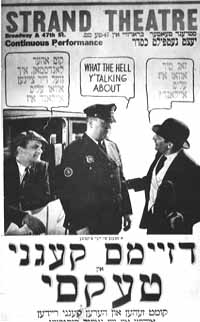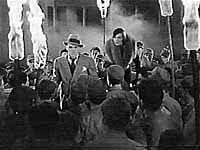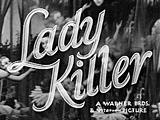
































|
 Yiddish advertisement for Taxi.
|
Cagney, comfortable in his own ethnicity and the polyglot tongues of New York, grins and responds with thick Irish brogue, "Delancey Street, thank-you." The Irish cop represents authority (controlling the large immigrant mass from Eastern Europe); Cagney, in his acceptance and ability to converse with immigrants, mediates that authority.
Cagney's image of mediation spoke to New York's immigrants (Italians, Jews, Poles, Slavs), who in 1930 comprised 54.1% of New York City's households. From 1932-39 (a period in which he made 25 films), Cagney represented an ethnic in-between.
|
 |
As an Irish-American and a primarily New York City star, Cagney was an icon for immigrants because he represented a complex simultaneity: he was both a part of and apart from Anglo-Saxon society. The Irish were the older immigrants, largely mainstreamed, but their Catholicism kept them outside of Protestant America. In a series of vehicles, Warner Brothers presented Cagney was an outsider/insider figure, a character who didn't want to conform to the dictates of the collective, but through the love of a WASPish woman or the demands of the authoritative Pat O'Brien, harnessed his energies to communal good.
Picture Snatcher (1933) was the first film, following Taxi, to present Cagney as an outsider/insider figure. As Danny Kean, Cagney plays a former gangster wanting to quit the rackets and go straight. Released from prison, he drops out of Jerry's gang and asks editor Ralph Bellamy for a job as a "picture snatcher," for a New York tabloid, The Graphic. "All my life I wanted to be something more than a gorilla," Cagney says, but his job is as crooked as the gangsters he later exposes. He befriends a grieving firefighter, whose wife's charred body was found in the arms of another man. Cagney pretends to be an insurance adjustor and while taking estimates steals a family portrait from the wall that features the unfaithful wife. It becomes a splash on the paper's front page. Later he also steals a pass to an electrocution at Sing Sing and with a camera strapped to his ankle snaps an illegal photograph of a dying woman. However, Kean does marginally redeem himself in the film's wrap-up. Trapped in a bullet-riddled apartment with former accomplice Jerry the Mug, Cagney, while protecting Jerry's neglected kids, snaps some great photographs of the gangster getting blasted by cops. As the gangster falls, we wrestle with ambiguities. Cagney supports family values and yet walks alongside the underworld. This kind of simultaneity is allegorically appealing to the immigrant. Cagney's underworld ties represent his ethnic difference, but his refusal to fire at the police suggests that he's crossed over to legitimacy. The film's conclusion further supports Cagney's mainstreaming, as he and Bellamy leave the sleazy tabloid for a more prestigious newspaper.
Mayor of Hell (1933) is a bristling film and Cagney's most fully realized immigrant text. He plays Joe "Patsy" Gargan a ward-heeler who for votes guaranteed to the city machine gets a cushy job at a state reform school. Upon arrival, Cagney is the irredeemable bad-boy, drinking from a flask and asking the crooked headmaster, Thompson, to make things look "regular." But upon meeting the WASPish Dorothy Griffith, he falls in love and with her help (she's the woman of ideas; he the man of action) decides to reform the reform school. The turning point occurs after Jimmy (Frankie Darro) is whipped against a fence and Thompson makes a disparaging comment about boys from city slums. Cagney, lips down-turned, gives a quick look of disgust, "That's where I come from. There's nothing a matter with me, is there?" Thompson tries to apologize but Cagney dismisses him with a curt, "Aw nuts," and aligns himself in background (product of east-side slums) and disrespectful attitude ("aw nuts") with the kids in the film and in the audience. As he exits the frame, moving in the direction of Dorothy, the infirmary, and the boys, he is no longer irresponsible but committed.
The film has several exciting scenes, including a sensational finale in which the boys seize control of munitions, arrest all the guards and try Thompson for murder.
|

The reform school becomes "Hell" in Mayor of Hell.
|
In a haunting moment that resonates the lynch mentality of KKK fanaticism and Frankenstein films, the boys brandish burning torches, and Thompson flees the mock courtroom. He climbs atop a barn roof, and as the boys surround him and set it ablaze, he slips to his death.
|
 |
As the school burns around them, Patsy, who had disappeared following a shoot-out with his own gang, returns under the initiative of Dorothy and tells the boys to put out the fire. He shows that he is willing to sacrifice himself for them. In turn, he asks that they surrender their rebellious spirit and accept the system. "We're all in the same boat," Patsy says, connecting his lawless action to theirs. Thematically, he espouses assimilation: "Don't be chumps. We've all got enough of a rap to beat, now. And the way to start beating it is by going back there and putting out that fire. Now what do you say, do we do it?" Patsy stresses a collective call to action for the boys in the film and the immigrant youth in the audience.
The film's conclusion, like that of Picture Snatcher, once again creates an ambiguous aura. Cagney remains the outsider/insider figure. As the boys look through the window, Cagney embraces Griffith, and our hero, the new head of the school, has a full-time job and more importantly has remained unpunished for shooting Gorilla Joe. The boys, too, aren't punished for the "murder" of Thompson. Thus the film ends in a state of flux between being in the norm or on the margins. The ending embodies the in-betweeness second generation immigrants feel, the confusion between choosing the traditions of their parents or following the trends of the larger society. Because Patsy and the boys are accepted (through marriage and the Juvenile Republic) and not punished for their hoodlum pasts, Mayor of Hell, allegorically, allows the immigrant spectators to assimilate and yet maintain their own ethnic differences (to be an hyphenated American).
Lady Killer (1933), a parody of Hollywood and the making of a star, is yet another variation on Cagney's outsider/insider simultaneity. The film opens with a typical Cagneyesque contradiction. The manager of New York's Strand Theater (where Cagney's films usually premiered) takes roll, and uniformed ushers in pill box hats and epaulets fall in line as the camera rapidly tracks back. A cutaway reveals Cagney. He is late, hurries from a roof top exit, wipes his knees, and runs toward the line. The manager broadly commends the ushers for the fine job they are doing, but he also threatens to fire those who chew gum on the job and/or indulge in "dice and crap games." Cagney, even though respectably uniformed, belongs to the latter group as he spits out a wad of gum at the first comment and grins at the second.
As Dan Quigley, former racketeer (what else?) turned matinee idol, Cagney's role asserts all of the prominent aspects of his pressbook persona: he's and rough handles women. This latter theme is foregrounded as Quigley and Myra (Mae Clarke) try to escape a police dragnet. While waiting to catch a Santa Fe train to Los Angeles, Clarke reads a brochure on sunny California. "Let's see what they've got. Ah-ha. Sunkist oranges, lemons, prunes, figs." Suddenly her tone drops and she gives a subtle, sly look, "grapefruit." Her comical aside to her moment of fame--the notorious "citrus massage" in Public Enemy--affirms Cagney's brutal domination of women (no doubt this element of his image appealed to insecure men during the dark days of the Depression).
 Later, the misogynistic violence of Public Enemy is topped as Quigley, now a big-time Hollywood star, discovers Myra in his apartment, threatening to expose his past if he isn't "nice" to her. Enraged, he drags her across the floor by her hair and lands her in the hall, bags and all. Variety criticized Cagney's "footballing negligee ladies thru hotel corridors" as being "just a little too bad" (01-02-34). Later, the misogynistic violence of Public Enemy is topped as Quigley, now a big-time Hollywood star, discovers Myra in his apartment, threatening to expose his past if he isn't "nice" to her. Enraged, he drags her across the floor by her hair and lands her in the hall, bags and all. Variety criticized Cagney's "footballing negligee ladies thru hotel corridors" as being "just a little too bad" (01-02-34).
Myra's return re-works Cagney's integration theme. Cagney/Quigley can't assimilate among Hollywood stars until he confronts his gangster past and destroys it. With his self-assured grin, Cagney gets into a violent speed chase with Duke's gang. Duke and Spade emerge from the accident, guns blazing. Quigley takes Myra's gun, hides her behind a tree, kills Duke and captures Spade. An elliptical edit reveals a sensational headline: "Cleared of All Charges, Star Asks Leniency for Myra Gale, Bandit Moll" and the film concludes with Quigley and flame Lois Underwood flying to Reno to get married. She kisses him and as the screen fades we are once again left with an uneasy simultaneity. Quigley, in taking action against his former gang destroys his history. His reformation to community values appears complete through marriage, but Cagney's persona maintains a romanticized bad-boy status--his involvement with racketeers goes unpunished. Again an aura of allegorical tension concludes the film as Cagney remains a figure in the mainstream (married) and on the fringes (unpunished outlaw), a part of and apart from society.
In 1933 Cagney's immigrant duality, the outsider/insider figure, was in its purest form and appealed to his Eastern-European fans many of whom were trying to bridge the gap between their old world past and their new world futures. His immigrant icon persona would continue to evolve throughout the decade, getting displaced into service vehicles (Here Comes the Navy [1934], Devil Dogs of the Air [1935] and "G" Men [1935]) in which the brash, cocky Cagney would learn to play by the rules and become a team player, or more highly budgeted prestige productions (Angels With Dirty Faces [1938] and The Roaring Twenties [1939]) in which Cagney sacrificed himself for communal good, helping wayward boys in the first film, creating a better world in the second.
By the 1940s, Cagney's immigrant image had radically changed under the pressures of the Martin Dies "communist" innuendoes. With war raging in Europe the competing images in Cagney's persona (the anarchic individual at odds with the collective; the Irish-American trying to make it in WASP society) were transformed into a homogenized pro-United States figure. The plight of the immigrant was replaced by Warners' all-American front to the Axis. Yankee Doodle Dandy (1942) culminated the change as Cagney's simultaneity was galvanized into a singing, dancing super-patriot.
Following a second try at independence (United Artists, 1943-48), the post-World War II Cagney struggled to maintain a contemporary persona. Much of his New York City audience had grown up and moved to the suburbs. Too old and lace-curtain Irish to remain an ethnic in-between, the post-war Cagney bifurcated into two types: a strong-willed patriarch (13 Rue Madeleine [1946], Come Fill the Cup [1951], Run for Cover [1955], These Wilder Years [1956], One, Two, Three [1961]) or a completely insane figure who needed to be destroyed (White Heat [1949], Kiss Tomorrow Goodbye [1950], A Lion is in the Streets [1953], Shake Hands With the Devil [1959]). White Heat mirrored the switch in emphasis. No longer was Cody Jarret fighting to realize the immigrant dream; instead he fought a mother complex.
Grant Tracey is the editor of Literary Magazine Review and an assistant professor at the University of Northern Iowa.
page 2 of 2

 Barbara Stanwyck Barbara Stanwyck
 Joan Crawford Joan Crawford
Go to sources.
Photo Credits: MGM/UA Home Video.
|
|











 Later, the misogynistic violence of Public Enemy is topped as Quigley, now a big-time Hollywood star, discovers Myra in his apartment, threatening to expose his past if he isn't "nice" to her. Enraged, he drags her across the floor by her hair and lands her in the hall, bags and all. Variety criticized Cagney's "footballing negligee ladies thru hotel corridors" as being "just a little too bad" (01-02-34).
Later, the misogynistic violence of Public Enemy is topped as Quigley, now a big-time Hollywood star, discovers Myra in his apartment, threatening to expose his past if he isn't "nice" to her. Enraged, he drags her across the floor by her hair and lands her in the hall, bags and all. Variety criticized Cagney's "footballing negligee ladies thru hotel corridors" as being "just a little too bad" (01-02-34).

 Barbara Stanwyck
Barbara Stanwyck Joan Crawford
Joan Crawford




